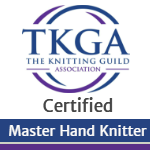I promised my guild that I would videotape my cutting the steeks for my sweater, so I figured to be thorough I’d do a whole post on the process. 🙂 Stay tuned for the actual video – this post will walk you through leading up to the actual cutting.
Just FYI – this is a picture heavy post!
For those that don’t already know, a steek is a section of knitting that you are planning on cutting in your knitting. You will use steeks when knitting things that are easier to knit in the round. Fair Isle (and stranded) knitting is very often knit in the round (it doesn’t have to be, though!) – so steeks are commonly used in those types of knitting. Why do you need to cut? Well, if you want a cardigan you have to have an opening in the front. You’ll need openings for the sleeves as well. And if you want a v-neck or scoop neck, you’ll need a neckline opening, too. These are all places you can use steeks. You’ll essentially knit a large tube for the body of your sweater, and then cut it open for the front, and cut open the armholes and the neckline.
I don’t usually reinforce my steeks – they don’t typically need it if you’re using a ‘sticky’ wool, and if you make an intrinsically sturdy steek of about 8 or more stitches wide and a checkerboard pattern. For this sweater, however, I used a very narrow steek of just 3 stitches on each side, and I used a stripe pattern. The reason for this is because I’m going to use a ‘sandwich’ technique when I pick up the stitches for the buttonband and the collar. (I’ll post about that when I get to that part of the sweater, too.) This technique requires the steek to be very narrow, since the steek will end up hidden inside a row of knitting. Because of this, I decided to reinforce all my steeks just to be extra sure they aren’t going anywhere. 🙂
Also, my steeks are all left with live stitches at the top, on holders – they need to be kept separate from the body of knitting, so I did not bind them off when the other stitches were bound off.
To reinforce, you need a small crochet hook and some yarn (I used the dark green color I’m going to be using on the buttonband.) Place a slip knot on the crochet hook, and insert your hook directly above the cast on edge of the steek – two stitches in from the center of the steek.



I’m working on the left side of the steek here, so the hook goes in from the left to the center- under the right leg of the second stitch from the center, and the left leg of the stitch directly in from the center (I have 3 stitches on each side of the center in this steek.)

Yarnover the hook, and pull through all three loops on the hook to make a slip stitch.


Repeat in this manner up the steek – getting every single row secured.


When you get to the top, the steek stitches are on a holder. Take the left three steek stitches and place them all on the hook.



Then yarnover once more and pull all the way through. Cut your yarn.

You need to repeat this process on the other side – but you need to work in towards the center from the right. So you’ll start with the live stitches at the top.



You will then be securing the left leg of the second stitch from the center and the right leg of the stitch to the right of center.

Yarnover the hook and pull through all 3 loops on hook. Continue down the steek.

Continue all the way down, ending by slip stitching over the cast on edge to secure it. Yarnover once more and pull all the way through. Cut your yarn.

You are now ready to cut!!

Stay tuned for my steeking video – I should be posting it soon!
I’m blocking my sweater today, so hopefully I’ll be able to start the finishing in a day or two! I’m nearing the finish line….





Hi Heather, Even though I don’t knit, the instructions were very easy to follow. You are really good at this. Thank you for all of us who have had a chance to read this.
Thanks Aunt Claudia! 🙂
Heather, what great pictures. Looking forward to seeing your video. Your sweater looks beautiful; can’t wait to see it completely finished!
Susan in Seattle (TKGA!)
Thanks Susan! I can’t wait to have it finally finished!! 🙂
Thanks for such an informative post. I love all the pictures- makes it very easy to understand. I’ll be doing a crochet reinforcement on the baby blanket I’m making before I steek so I’ll definitely look to this post for guidance when doing so
You’re very welcome! I do my crochet reinforcement a tiny bit differently than some other tutorials – I only do a slip stitch chain, but many others do a single crochet chain – either way works! The single crochet method is perhaps a tad bit even more secure, but I like the slip stitch since it’s less bulky.